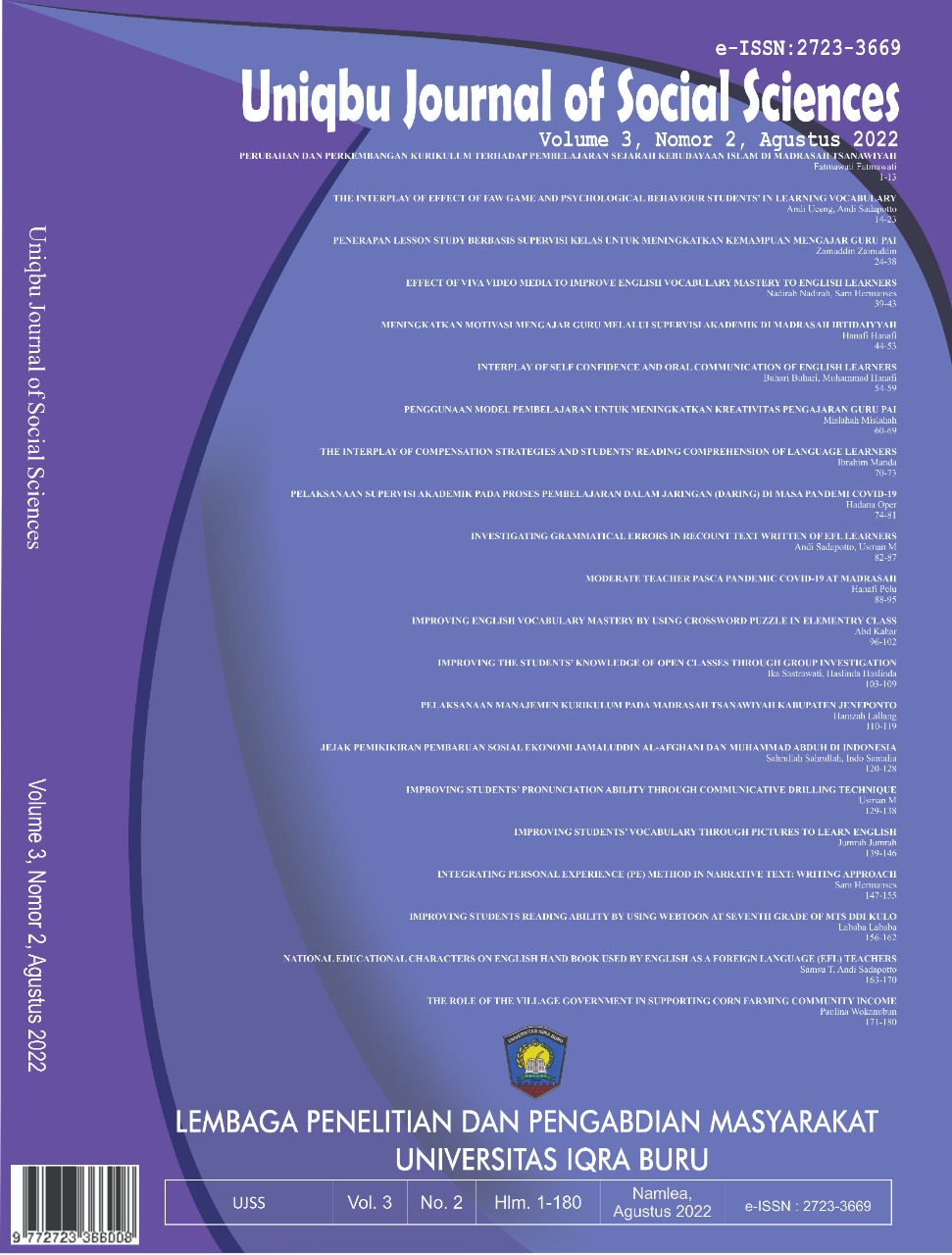IMPROVING STUDENTS’ PRONUNCIATION ABILITY THROUGH COMMUNICATIVE DRILLING TECHNIQUE
DOI:
https://doi.org/10.47323/ujss.v3i2.224Keywords:
communicative drilling and pronunciation abilityAbstract
The objective of the research were to find out : (1) whether or not the ability the use of Communicative Drilling increased pronunciation ability of the second year students at SMP Negeri 4 Pancarijang and (2) whether or not the second year students of SMP Negeri 4 Pancarijang are interested in pronunciation through Communicative Drilling. This research applied Pre-experimental method that apllied one group pretest and posttest. The subject of the research was the second year students of SMP Negeri 4 Pancarijang academic year 2018 – 2019.total number of population was 92 students spread in three classes and one class of them VIII.3 were taken as sample by using cluster sampling technique. The data of the research were collected by using twi kinds of instruments, namely pronunciation test and questionnaire. Pronunciation test was used to obtain data of the students’ pronunciation ability and questionnaire was used to know the students interest in pronunciation by using communicative drilling. The result of data analysis showed that the mean score of post test (70) was higher than the mean score of post test ( 28). This showed that was significant difference between the students before and after taught by using communicative drilling. Then, the analysis of interest by using Linkert Scale indicated that the students were interested to pronounce English through communicative drilling. It was proved by mean score of students’ interest was (79.9) in categories in interest. The result of the t-test value (7.29) was greater than t-table (α = 0,05: 16 = 2.120). This mean that H1 was accepted. Based on data analysis, the researcher concluded that teaching pronunciation by using Communicative Drilling increased the students’ ability to pronounce English. Moreover, the use of Communicative drilling makes the students’ interested in pronouncing English.
References
Akmaijan, A., Demers, RA., Farmer, A K & R.M. 1998. Linguistics : an introduction to Language and Communication, 4h edn, MIT Press, Cambridge, London.
Bachman, L. 1990 Fundamental Considerations in Language Testing. New York: Oxford University Pres.
Bin-Tahir, S. Z., Atmowardoyo, H., Dollah, S., Rinantanti, Y., & Suriaman, A. (2018). MULTILINGUAL AND MONO-MULTILINGUAL STUDENTS’PERFORMANCE IN ENGLISH SPEAKING. Journal of Advanced English Studies, 1(2), 32-38.
Bin-Tahir, S. Z., Hanapi Hanapi, I. H., & Suriaman, A. (2020). Avoiding Maluku Local Languages Death Through Embedded Multilingual Learning Model: Menghindari Kematian Bahasa Daerah Maluku melalui Model Pembelajaran Embedded Multilingual. Uniqbu Journal of Social Sciences, 1(1), 53-60.
Brown, D.H 2001. Teaching by Principles: An Interactive Aprroach to Language Pedagogy. 2nd. Ed. New York: Pearson Education.
Burns, A 2003. Clearly speaking: pronunciation in action for teachers. National Center for English Language Teaching and Research, Macquaire Universty, Sydney NSW 2019.
Celce-Murcia, M. 2006. Teaching English as a Second or Foreign Language. 3rd ed. Singapore: Heinle & Heinle.
Dobrovolsky. 1989. Phonetic : The sounds of Language.
Dr. K. Venkata Subbaiah, Fiaz Khan, Challa Suresh (2017) Optimization of Process Parameters in CNC Drilling of EN 36. Pdf format available at http://www.internationaljournalssrg.org/IJME/2017/Special-Issues /NCRAME/IJME¬- NCRAME-P133.pdf
Giergerich, Heinz J. 1992. English Phonology: an Introduction. Cambridge:
Cambridge University Press
Gilakjani, Abbas Pourhossein. 2002. The significance of Pronunciation in English Teaching. www.researhgate.net
Gilakjani, Abbas Pourhossein. 2012. A Study of Factors Affecting EFL Learners’ English Pronunciation Learning And the Strategies for Instruction. Internatioanal Journal of Humanities and Social Science 2.3, 119-128
Handoko, Kenny Ckristian, Mindari, Ruruh (2016) Using Drilling to Teach Pronunciation to the Seventh Graders. Pdf format available at http://repository.wima.ac.id/6215/
Howlader, Mohammad Rasel 2001. Approaches to Developing pronunciation in a Second Language: A study in Banglades. ASA University.
Ilham. 2013. Increasing students’ pronunciation ability of the second years students’ through reading aloud at STKIP Muhammadiyah Sidrap
Heaton, J.B. Classroom Testing. London: Longman, 1990.127 p.
Heaton, J.B. Writing English Language tests. 1st edition. London: Longman, 1988. 160 p.
Kang, O. 2010. ESL learners’ attitudes toward pronunciation instruction and varieties of English. In J. Levis & K. LeVelle (eds). Proceedings of the 1st Pronunciation in Second Language Learning and Theaching Conference. Ames, IA: Iowa State University, 105-118.
Kelly, Gerald. 2000. How to Teach Pronunciation. Essex: Pearson Education.
Kenworthy, Joanne. 1987. Teaching English Pronunciation. Essex: Addision Wesley Longman Ltd.
Maharida. 2017. Using Substitution Drill Technique To Improve Students’ Pronunciation Ability. Pdf format available at www.researchgate.net
Nunan, D. 1991. Languange Teaching Methodology : a textbook for teacher. Prencite Hall International English Language Teaching.
Nurani, Siti. Rosyada, Amrina. 2015. Improving English Pronunciation of Adult ESL Learners through Reading Aloud Assessments at https://journal.binus.ac.id
Riyanto, Yatim. 2001. Metodologi Penilitian Pendidikan. Penerbit SIC.
Seidlhofer, B. 1995. “Pronunciation Awareness:Some thoughts on pronunciation in teacher education”. Speak Out! Newsletter of the IATEFL Pronunciation Special Interest Group, 6, p. 12-16.
Soon, Goh Ying, Saiful Nizam. Al Marimuthu, Rasaya. Abdul Wahab Naemah, Othman, Jam. And Peng, Chenk Slak. (2017). Improving Pronunciation Accruacy of Oral Production Using Online Chinese Pinyin Text To Speech System. Pdf format available at www.iarjournal.com



